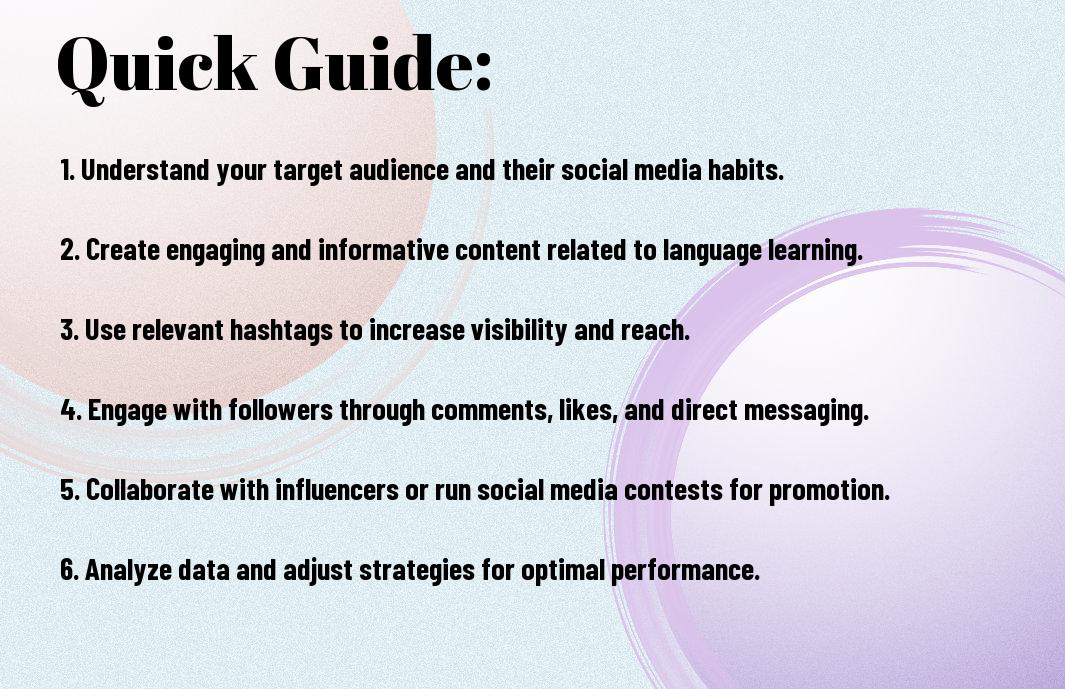You, as a language school owner or administrator, understand the importance of effective social media marketing in reaching potential students and growing your business. In today’s digital age, having a strong online presence is crucial for success. Social media platforms offer a powerful way to engage with your audience, showcase your school’s unique offerings, and ultimately drive enrollment. However, navigating the world of social media marketing can be challenging without the right strategies in place.
From choosing the right platforms to creating engaging content and analyzing performance, there are many key factors to consider when developing a social media marketing strategy for your language school. In this guide, we will break down the important steps to help you master social media marketing for your language school. By implementing these strategies, you will be able to attract the right audience, increase brand awareness, and boost student enrollment.
Whether you are new to social media marketing or looking to optimize your current efforts, this guide will provide you with the tools and insights needed to succeed in the competitive landscape of language education. By leveraging the power of social media, you can position your language school as a leader in the industry and connect with students from around the world. Let’s dive in and transform your social media presence to drive your language school’s growth and success.
Key Takeaways:
- Define your target audience: Understanding who your ideal students are will help tailor your social media content to better reach and engage with them.
- Create a content calendar: Plan out your social media posts in advance to ensure consistency and to maintain a strong presence online.
- Utilize visual content: Incorporate photos, videos, and other visually appealing content to grab the attention of your audience and make your posts more engaging.
- Engage with your followers: Respond to comments, messages, and mentions to build a sense of community and show that you value your students.
- Run social media ad campaigns: Invest in targeted advertising to reach a larger audience and promote your language school effectively.
- Monitor analytics: Keep track of your social media metrics to understand what content is resonating with your audience and make data-driven decisions to improve your strategy.
- Cross-promote with partners: Collaborate with other businesses or influencers in the language learning industry to expand your reach and attract new students.

Understanding the Different Types of Social Media Platforms
Little do language schools realize that social media marketing can be a powerful tool to reach out to potential students. To truly master social media marketing for language schools, one must first understand the different types of social media platforms available.
- Facebook: With over 2 billion monthly active users, Facebook remains the largest social media platform globally. It is a great platform for language schools to showcase their courses, share testimonials, and engage with their audience through posts and live videos.
- Instagram: This visually-driven platform is perfect for language schools to showcase their campus, classrooms, and student life. With over half a billion monthly active users, language schools can leverage Instagram to attract potential students through eye-catching visuals.
- Twitter: With its fast-paced nature, Twitter is ideal for language schools to share quick updates, language tips, and industry news. It has around 500 million monthly active users, making it a platform that language schools should not overlook.
- LinkedIn: This platform is great for language schools to connect with professionals looking to enhance their language skills for career growth. With over 1 billion members, language schools can share industry insights and network with potential students on LinkedIn.
- YouTube: As the second largest search engine after Google, YouTube is a valuable platform for language schools to share tutorial videos, student testimonials, and virtual campus tours to attract and engage with their audience.
Overview of Major Social Media Networks and Their User Demographics
While Facebook appeals to a wide range of age groups, Instagram attracts a younger audience, making it ideal for targeting millennial and Gen Z students. Twitter is popular among professionals and influencers, while LinkedIn caters to a more business-oriented audience. YouTube is a diverse platform that appeals to all age groups and demographics, making it an vital platform for language schools to leverage.
Niche Platforms and Community Forums
With the rise of niche platforms and community forums, language schools can now tap into specific interest groups and communities to target potential students with laser-focused precision. Platforms like Reddit, Quora, and Discord allow language schools to engage with users who are actively seeking language learning resources and advice.
To truly master social media marketing for language schools, it is crucial to not only focus on major social media networks but also explore niche platforms and community forums where engagement and authentic interactions can lead to strong connections with potential students. By understanding the different types of social media platforms and their user demographics, language schools can tailor their marketing strategies to reach the right audience effectively.
Crafting Your Language School’s Social Media Strategy
Setting Clear Marketing Goals
Now is the time to define your language school’s social media marketing goals. It is crucial to have a clear understanding of what you want to achieve through your online efforts. Whether it is increasing brand awareness, driving website traffic, generating leads, or improving customer engagement, your goals should be specific, measurable, achievable, relevant, and time-bound. Setting clear marketing goals will provide your team with a roadmap for success and help track progress along the way.
Identifying Key Performance Indicators (KPIs)
Any social media strategy for your language school must be backed by relevant Key Performance Indicators (KPIs). These KPIs will help you measure the effectiveness of your efforts and determine if you are meeting your marketing goals. Identifying Key Performance Indicators such as reach, engagement, conversion rates, and customer retention will provide you with valuable insights into the performance of your social media campaigns.
Furthermore, Identifying Key Performance Indicators allows you to make data-driven decisions and optimize your social media strategy for better results. By regularly monitoring and analyzing these KPIs, you can identify trends, opportunities, and areas for improvement, ultimately helping you refine your marketing efforts and achieve greater success on social media.

Developing Engaging Content for Your Audience
The Content Mix: Informational, Promotional, and Interactive Posts
After identifying your target audience and understanding their needs, it’s crucial to develop a content mix that caters to their interests. A successful social media strategy for language schools includes a variety of posts that blend informational, promotional, and interactive content. Informational posts should provide valuable insights, tips, and resources related to language learning. Promotional posts can showcase your language courses, events, and special offers. Lastly, interactive posts such as polls, quizzes, and challenges encourage engagement and create a sense of community among your followers.
Visual Storytelling: Using Images and Videos Effectively
Little can capture attention on social media like visually appealing content. Images and videos are powerful tools for storytelling and creating a memorable brand image for your language school. Utilize high-quality images of your classrooms, students, and cultural events to showcase the unique experience your school offers. Similarly, create engaging videos that provide a glimpse into your teaching methods, student testimonials, and fun language-learning activities.
While visual content is imperative, it’s crucial to maintain a balance between images and videos in your social media strategy. Images are great for capturing moments and sharing quotes, while videos allow for more dynamic storytelling and in-depth exploration of topics related to language learning. Experimenting with different formats will help you understand what resonates best with your audience and tailor your content accordingly.
Creating a Content Calendar
One of the keys to consistency in social media marketing is having a well-planned content calendar. This calendar should outline the types of posts you will share, the frequency of posting, and the platforms you will use. Using scheduling tools like Publer, Hootsuite, or Buffer can help you organize your content calendar efficiently and ensure that your posts go out at optimal times for maximum visibility. Remember to include holidays, language-related observances, and school events in your calendar to keep your content timely and relevant.

Step-by-Step Guide to Building a Social Media Presence
Your language school’s social media presence is crucial in today’s digital age. To effectively reach your target audience and engage with potential students, you must master the art of social media marketing. This step-by-step guide will walk you through the process of building a strong social media presence for your language school.
Creating and Optimizing Social Media Profiles
| Step 1: Research and select the most relevant social media platforms for your language school. | Step 2: Ensure that your profiles are complete with a clear description, profile picture, cover photo, and contact information. |
| Step 3: Use keywords related to language learning in your profile to optimize searchability. | Step 4: Regularly update your profiles with engaging content to keep your audience interested. |
Content Scheduling and Automation Tools
Now, let’s discuss the importance of content scheduling and automation tools in maintaining a consistent social media presence for your language school. By using tools like Hootsuite, Publer (my personal favorite), or Buffer, you can schedule posts ahead of time, analyze performance metrics, and engage with your audience more efficiently.
Automation tools allow you to streamline your social media efforts, saving time and ensuring that your posts are published at optimal times for maximum visibility. These tools also help you maintain a consistent posting schedule, which is vital for keeping your audience engaged and growing your following.
When using content scheduling and automation tools, it’s important to strike a balance between automated and real-time engagement. While automation can help you stay organized and save time, it’s crucial to prioritize authentic interactions with your followers to build trust and credibility for your language school.
Community Management and Interaction Techniques
Community management is a vital aspect of social media marketing for language schools. Engaging with your audience, responding to comments and messages, and participating in relevant conversations are key to fostering a strong online community. Utilize techniques such as hosting Q&A sessions, running contests, and sharing user-generated content to encourage interaction and build relationships with your followers.
Media: Social media is a two-way street, so make sure to actively listen to feedback from your audience and adjust your strategies accordingly. By showing that you value their input, you can create a more loyal and engaged community around your language school.
Step-by-Step: Bear in mind, consistency is key when building a social media presence for your language school. By following these steps and leveraging the right tools and techniques, you can effectively grow your online presence and attract more students to your language programs.
Leveraging Paid Social Media Advertising
The Basics of Social Media Advertising
All successful language schools know that social media advertising is an important tool in reaching potential students. While organic reach is important, paid social media advertising allows schools to target specific demographics, interests, and behaviors, ensuring that their ads are seen by those most likely to enroll.
Mastering the basics of social media advertising involves understanding the different platforms available for advertising, setting clear objectives for each campaign, creating compelling ad content, and analyzing performance metrics to optimize future campaigns. Language schools can use features like custom audiences, lookalike audiences, and ad retargeting to maximize the effectiveness of their paid campaigns.
By investing in paid social media advertising, language schools can amplify their online presence, increase brand awareness, drive website traffic, and ultimately boost student enrollment. The key is to continuously refine strategies based on data insights and audience feedback to ensure maximum return on investment.
Designing Effective Ads for Language Learning
Language schools must create ads that not only grab attention but also effectively communicate their unique selling propositions and benefits to potential students. Visual elements, such as high-quality images or videos, are important in capturing audience interest and conveying the school’s brand message. Media schools can experiment with different ad formats, such as carousel ads, slideshow ads, or interactive polls, to see what resonates best with their target audience.
Language is key. Tailoring ad copy to the language proficiency level of the target audience can significantly impact ad performance. Utilizing strong call-to-action phrases and highlighting the value proposition of the language courses can further enhance ad effectiveness. Designing ads that are both educational and engaging can set language schools apart from competitors and drive higher click-through rates.
Including social proof, such as student testimonials or success stories, in ads can build credibility and trust among potential students. A/B testing different ad creatives, messaging, and targeting options can help language schools identify what resonates best with their audience and refine their advertising strategies over time.
Budgeting and Monitoring Ad Spend
While social media advertising can be a cost-effective way to promote language schools, it’s crucial to set a clear budget and monitor ad spend to ensure optimal results. Establishing key performance indicators (KPIs) upfront can help schools track the success of their campaigns and make data-driven decisions to improve performance.
Monitoring ad metrics such as click-through rate, conversion rate, cost per acquisition, and return on ad spend is important in determining the effectiveness of campaigns. Adjusting ad budgets based on the performance of individual ads or campaigns can help language schools allocate resources more efficiently and maximize ROI. The ability to track and analyze ad performance in real-time allows schools to make timely adjustments and optimize their advertising strategies for better results.
Tips for Engaging with Students and Prospective Learners
Unlike traditional marketing methods, social media marketing provides language schools with a unique platform to engage directly with their students and prospective learners. In order to effectively connect and build relationships with your audience, consider the following tips:
- Utilize hashtags strategically to reach a wider audience
- Create engaging content that encourages interaction
- Respond promptly to messages and comments to show your dedication to customer service
This approach will help create a more dynamic and engaging social media presence that attracts, retains, and nurtures students and prospective learners.
Use of Hashtags and Keywords for Higher Visibility
Some of the most powerful tools for increasing visibility on social media platforms are hashtags and keywords. By incorporating relevant keywords and trending hashtags in your posts, you can significantly improve your chances of reaching a larger audience. Research popular hashtags within the language learning community and incorporate them strategically into your posts to increase visibility and engagement.
Additionally, using keywords related to your language school, courses, and unique selling points can help your posts appear in search results and attract the attention of students actively seeking language learning opportunities. Remember to strike a balance and avoid overloading your posts with hashtags, as this can appear spammy and deter potential followers. This targeted approach will ensure that your social media content is seen by the right audience.
Conducting Polls, Contests, and Challenges
Challenges can be an effective way to engage students and prospective learners by encouraging participation and interaction on social media platforms. Hosting polls, contests, and challenges that are related to language learning can create a sense of community and excitement around your language school. Consider creating language-related quizzes, challenges to practice vocabulary, or contests that reward creative language use. These activities not only promote engagement but also showcase your language school’s expertise and commitment to language learning.
Plus, conducting polls, contests, and challenges on social media can generate buzz and increase visibility for your language school. Participants may share their experiences with their followers, further extending your reach and attracting new students. Make sure to promote these activities across all your social media channels to maximize participation and engagement.
Factors Influencing the Success of Your Social Media Efforts
Importance of Consistency and Authenticity
Keep consistency and authenticity at the forefront of your social media marketing efforts for your language school. Your audience appreciates consistency in your posting schedule, tone, and messaging. It helps in building brand loyalty and trust. Furthermore, staying true to your school’s values and mission will attract an audience that aligns with your offerings, leading to higher conversion rates.
Some language schools make the mistake of trying to imitate competitors or use inauthentic language to appeal to a broader audience. However, this approach can backfire and lead to a loss of credibility. Embrace your uniqueness and let it shine through in your social media content. Authenticity is key to forming genuine connections with your followers and fostering long-term relationships.
Consistent and authentic social media presence not only helps in attracting new students but also in retaining existing ones. By showcasing the real value of your language school through your posts, you will create a community that is engaged and loyal to your brand. The consistency and authenticity of your content will set you apart in a crowded social media landscape.
Adapting to Trends and Algorithm Changes
Some language schools underestimate the importance of staying updated on the latest social media trends and algorithm changes. Platforms like Facebook, Instagram, and Twitter frequently update their algorithms, impacting the visibility of your content. It is crucial to adapt quickly to these changes and optimize your strategies accordingly to maintain a strong online presence.
Being aware of emerging trends in social media marketing allows you to stay ahead of the competition and reach your target audience effectively. Whether it’s leveraging new features like Instagram Reels or utilizing influencer partnerships, embracing these changes can elevate your social media game. Adapting to trends and algorithm changes demonstrates your language school’s agility and commitment to staying relevant in the digital landscape.
To succeed in social media marketing for language schools, it is imperative to monitor performance metrics regularly and adjust your strategies based on the data. Analytics provide valuable insights into what is working and what is not, enabling you to make data-driven decisions for improved results. Stay proactive in analyzing your social media data to refine your approach and maximize the impact of your efforts.
The Role of Analytics and Data-Driven Decisions
Analyze your social media performance using analytics tools to track key metrics such as engagement, reach, and conversion rates. These data-driven insights will guide your decision-making process and help you tailor your content to better resonate with your audience. By delving into the numbers, you can identify opportunities for growth and optimize your social media strategy for success.
Data-driven decisions empower you to allocate resources effectively, invest in high-performing content, and refine your targeting strategies. By leveraging analytics to inform your social media efforts, you can make informed decisions that lead to tangible results. Embrace the power of data in shaping your language school’s social media presence for long-term success.
The Pros and Cons of Outsourcing Social Media Marketing
| Pros | Cons |
| Access to expertise and experience | Lack of direct control |
| Cost-effective | Potential communication barriers |
| Time-saving | Quality may vary |
| Can lead to improved results | Risk of confidentiality breaches |
When to Consider Outsourcing
Any language school looking to scale its online presence and reach a wider audience should consider outsourcing social media marketing. If your in-house team lacks the expertise or bandwidth to effectively handle social media campaigns, outsourcing can provide access to specialized knowledge and resources. Additionally, if your school is experiencing stagnant growth or declining engagement on social platforms, outsourcing to a professional agency can breathe new life into your online marketing efforts.
Furthermore, if you are struggling to keep up with the ever-changing algorithms and trends of social media platforms, outsourcing to experts who stay updated on the latest industry developments can give your school a competitive edge. By entrusting your social media marketing to experienced professionals, you can focus on other aspects of running your language school while knowing that your online presence is in capable hands.
Marketing a language school effectively on social media requires a deep understanding of the target audience, content creation, analytics, and engagement strategies. Outsourcing to a reputable social media marketing agency can ensure that your school’s online presence reflects its unique brand voice and values. Collaborating with experts who have a proven track record in the education sector can help your school stand out in a crowded digital landscape and attract prospective students.
Choosing the Right Social Media Marketing Agency
Marketing your language school on social media requires more than just posting occasional updates. To truly make an impact and drive results, it is crucial to partner with a social media marketing agency that understands the nuances of the education industry and has a track record of success in promoting language schools. When identifying an agency, look for a team that demonstrates a deep understanding of your target audience, utilizes data-driven strategies for content creation and engagement, and provides regular performance reports to track the success of your campaigns.
Building a Community Around Your Language School
Not only does social media provide language schools with a platform to connect with their audience, but it also allows for the building of a vibrant online community. Engaging with students, alumni, and potential learners can create a sense of belonging and loyalty towards the language school. By fostering a community around your school, you can encourage interaction, discussions, and a sense of unity among your followers.
Strategies for Creating an Engaged Online Community
If you want to create an engaged online community around your language school, consider implementing strategies such as regular posting of relevant content, hosting live Q&A sessions, and organizing contests or challenges to spark interest. Encourage active participation by responding to comments and messages promptly, and show appreciation for your community’s contributions. Collaborating with influencers or alumni can also help in expanding your reach and attracting new followers.
Integrating Social Media with Other Marketing Efforts
Education is key when it comes to integrating social media with other marketing efforts for your language school. Ensure that your social media strategy aligns with your overall marketing goals and brand image. By utilizing social media platforms in conjunction with email marketing, SEO strategies, and traditional advertising, you can create a cohesive and effective marketing campaign that reaches a wider audience. Track and analyze the performance of your social media efforts to make data-driven decisions and optimize your marketing strategies.
Encouraging engagement and interaction across all your marketing channels can lead to a more cohesive and impactful outreach. By integrating social media with your other marketing efforts, you can increase brand visibility, enhance customer relationships, and drive student enrollment for your language school.
To wrap up
Presently, social media marketing plays a vital role in the success of language schools worldwide. By implementing effective strategies and techniques, language schools can effectively promote their programs, engage with students and prospects, and build a strong online presence. From creating engaging content to utilizing targeted advertising, mastering social media marketing can help language schools reach a wider audience and achieve their enrollment goals.
For language schools looking to enhance their social media marketing efforts, it is imperative to stay updated on the latest trends and best practices in the industry. By following the 9 Actionable Tips for Effective Language School Marketing, schools can gain valuable insights and guidance on how to optimize their social media channels and achieve marketing success. Embracing these strategies can help language schools stand out in a competitive market and attract more students to their programs.
Overall, mastering social media marketing for language schools requires a combination of creativity, consistency, and strategic planning. With the right approach, language schools can leverage the power of social media to connect with their target audience, showcase their unique offerings, and ultimately drive enrollment. By implementing the tips and strategies outlined in this article, language schools can take their social media marketing efforts to the next level and position themselves for long-term success in the industry.
FAQ
Q: Why is social media marketing important for language schools?
A: Social media marketing helps language schools reach a wider audience, engage with current students, build brand awareness, and drive enrollment.
Q: What are the key social media platforms for language school marketing?
A: The key platforms for language school marketing include Facebook, Instagram, LinkedIn, and Twitter. Each platform offers unique opportunities to connect with your audience.
Q: How can language schools use social media to attract new students?
A: Language schools can attract new students by creating engaging content, showcasing student testimonials, offering promotions, and hosting virtual events on social media platforms.
Q: What type of content performs well on social media for language schools?
A: Content that performs well for language schools on social media includes language learning tips, student success stories, cultural insights, behind-the-scenes glimpses, and interactive posts like polls and quizzes.
Q: How can language schools engage with their social media audience effectively?
A: Language schools can engage with their audience effectively by responding to comments and messages promptly, running contests or giveaways, posting regularly, and sharing user-generated content.
Q: What are some social media marketing strategies that language schools can implement?
A: Some social media marketing strategies for language schools include creating a content calendar, collaborating with influencers or other businesses, using paid advertising campaigns, and analyzing metrics to track performance.
Q: How can language schools measure the success of their social media marketing efforts?
A: Language schools can measure the success of their social media marketing efforts by tracking key metrics such as engagement rate, follower growth, website traffic from social media, and conversion rates for enrollment or inquiries.
Do you want to grow your Language School?
We offer a free 15-minute Discovery Call: https://api.leadconnectorhq.com/widget/booking/S3yIfmrMHbpAfakuYrXA. In this short call, we’ll learn more about your language school and let you know whether we can help you with your goal or not.
If we think we can help you, we’ll invite you to a planning session where we’ll map out your entire marketing strategy (the cost for this is just $500).



